Salmonella spp antibody latex agglutination detection method
A detection method and technology for Salmonella, applied in the field of immunology, can solve the problems of difficulty, fast and accurate, simple and easy to implement, and achieve the effects of fast and accurate method, high accuracy, strong specificity and immunogenicity
- Summary
- Abstract
- Description
- Claims
- Application Information
AI Technical Summary
Problems solved by technology
Method used
Image
Examples
Embodiment 1
[0047] Example 1 Expression of SEN4030a protein
[0048] 1 Construction of recombinant plasmids
[0049] 1.1 Genomic DNA extraction of Salmonella enteritis
[0050] ⑴. Take 1ML of the overnight shaking culture in a clean centrifuge tube, centrifuge at 12000rpm for 1min, and aspirate the supernatant.
[0051] ⑵. Add 300 μL 65°C preheated resuspension solution to the bacterial pellet, and mix well by pipetting.
[0052] (3) Add 150 μL of 65°C preheated lysate to the solution, mix by inverting, and then place in a 65°C water bath for 5 minutes.
[0053] ⑷. Add 200 μL of chloroform, vortex and mix for 20 seconds. At this time, it becomes milky white and turbid. Centrifuge at 12,000 rpm for 2 minutes. Move the supernatant to a new centrifuge tube to avoid touching the white film in the middle.
[0054] ⑸. Add 1.5 times the volume of membrane binding solution to the supernatant, invert and mix well, aspirate into the adsorption column, place at room temperature for 2 minutes, the...
Embodiment 2
[0086] Induced expression of embodiment 2 target protein
[0087] 2.1 Culture of positive bacteria
[0088] The positive strains screened by PCR were shaken at 37°C. When the OD of the bacterial solution was 0.4-0.8, 0.5mmoL / LIPTG was added to induce protein expression. After expressing for 4 hours, the bacterial solution was collected, ultrasonically lysed and centrifuged, and the supernatant and precipitate were separated. SDS-PAGE electrophoresis showed obvious bands in both the supernatant and the precipitate, which proved that the protein expression existed in two forms: soluble protein and inclusion body, such as Figure 6 shown.
[0089] Inclusion bodies are generally formed when exogenous genes are expressed in E. coli. Due to the excessive protein synthesis speed, the protein cannot be folded correctly, and thus exists in the form of inclusion bodies. Many experimental studies have shown that appropriately reducing the expression temperature and the number of shaker ...
Embodiment 3
[0097] Embodiment 3 latex agglutination experimental method
[0098] The MES buffer used in this example is 40mmol / L MES buffer, and the preparation method is: MES 7.81g, add an appropriate amount of deionized water, then adjust the pH value to 6.1 with concentrated hydrochloric acid, and dilute to 1L with deionized water .
[0099] The preparation method of 0.01M PBS buffer pH7.2 is: NaCl 8.0g, KCl 0.2g, KH2PO4 0.2g, Na2HPO4·12H2O 2.9g, add deionized water to 1L, adjust the pH to 7.2 with concentrated hydrochloric acid.
[0100] 3.1 Latex pretreatment
[0101] Take 0.1 μL, 2.5% (w / v) blank latex microspheres, add 10ml deionized water, centrifuge at 12000rpm for 15min, then add 10mL MES buffer to dilute to 1% (v / v), add Triton X-100, the concentration is 0.05% (v / v), to obtain a blank latex microsphere solution.
[0102]3.1 Preparation of sensitized latex microspheres
[0103] The above pretreated blank latex microsphere solution was mixed with the SEN4030a protein solutio...
PUM
| Property | Measurement | Unit |
|---|---|---|
| Concentration | aaaaa | aaaaa |
Abstract
Description
Claims
Application Information
 Login to View More
Login to View More - R&D Engineer
- R&D Manager
- IP Professional
- Industry Leading Data Capabilities
- Powerful AI technology
- Patent DNA Extraction
Browse by: Latest US Patents, China's latest patents, Technical Efficacy Thesaurus, Application Domain, Technology Topic, Popular Technical Reports.
© 2024 PatSnap. All rights reserved.Legal|Privacy policy|Modern Slavery Act Transparency Statement|Sitemap|About US| Contact US: help@patsnap.com










